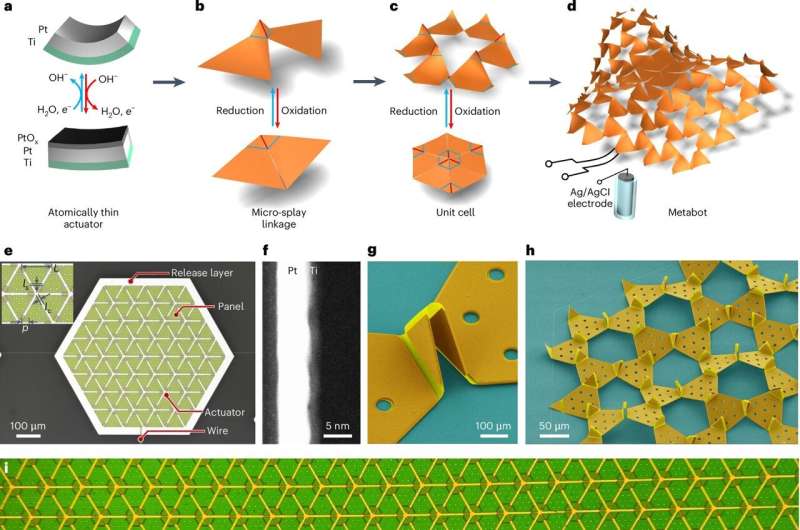This article has been reviewed according to Science X's editorial process and policies. Editors have highlighted the following attributes while ensuring the content's credibility:
fact-checked
peer-reviewed publication
trusted source
proofread
Versatile microscale robots can fold into 3D shapes and crawl

Cornell University researchers have created microscale robots less than 1 millimeter in size that are printed as a 2D hexagonal "metasheet," but with a jolt of electricity, morph into preprogrammed 3D shapes and crawl.
The robot's versatility is due to a novel design based on kirigami, a cousin of origami, in which slices in the material enable it to fold, expand and locomote.
The team's paper, "Electronically Configurable Microscopic Metasheet Robots," appears in Nature Materials. The paper's co-lead authors are postdoctoral researchers Qingkun Liu and Wei Wang. The project was led by Itai Cohen, professor of physics. His lab has previously produced microrobotic systems that can actuate their limbs, pump water via artificial cilia and walk autonomously.
In a sense, the origins of the kirigami robot were inspired by "living organisms that can change their shape," Liu said. "But when people make a robot, once it's fabricated, it might be able to move some limbs but its overall shape is usually static. So we've made a metasheet robot. The 'meta' stands for metamaterial, meaning that they're composed of a lot of building blocks that work together to give the material its mechanical behaviors."
The robot is a hexagonal tiling composed of approximately 100 silicon dioxide panels that are connected through more than 200 actuating hinges, each about 10 nanometers thin. When electrochemically activated via external wires, the hinges form mountain and valley folds and act to splay open and rotate the panels, allowing the robot to change its coverage area and locally expand and contract by up to 40%. Depending on which hinges are activated, the robot can adopt various shapes and potentially wrap itself around other objects, and then unfold itself back into a flat sheet.
Cohen's team is already thinking of the next phase of metasheet technology. They anticipate combining their flexible mechanical structures with electronic controllers to create ultra-responsive "elastronic" materials with properties that would never be possible in nature. Applications could range from reconfigurable micromachines to miniaturized biomedical devices and materials that can respond to impact at nearly the speed of light, rather than the speed of sound.
"Because the electronics on each individual building block can harvest energy from light, you can design a material to respond in programmed ways to various stimuli. When prodded, such materials, instead of deforming, could 'run' away, or push back with greater force than they experienced," Cohen said. "We think that these active metamaterials—these elastronic materials—could form the basis for a new type of intelligent matter governed by physical principles that transcend what is possible in the natural world."
More information: Qingkun Liu et al, Electronically configurable microscopic metasheet robots, Nature Materials (2024). DOI: 10.1038/s41563-024-02007-7
















